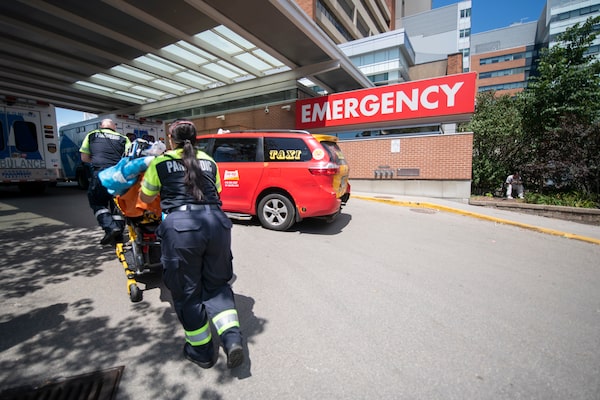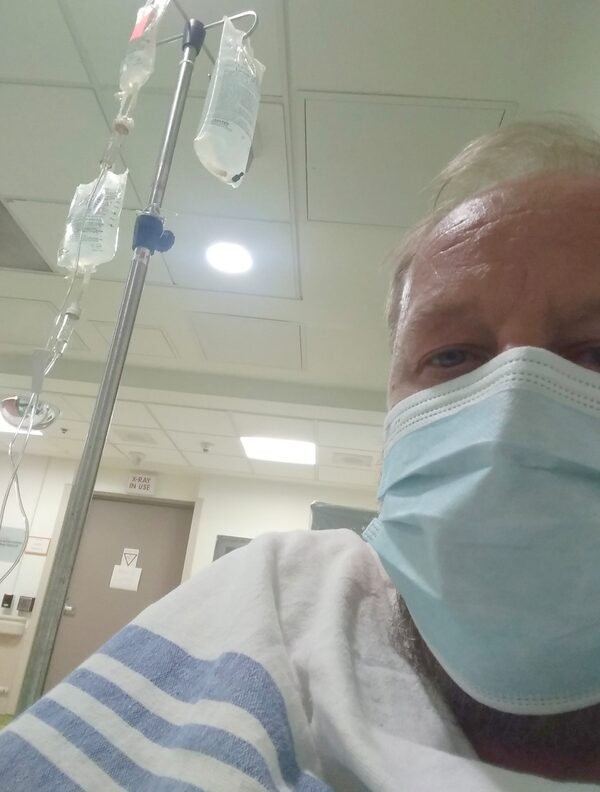
Paramedics bring a patient to the emergency department at Toronto Western Hospital on July 14.Fred Lum/The Globe and Mail
Hospital emergency departments in Canada have long struggled to provide expeditious care. But now, more than two years into the pandemic, many are showing signs of buckling, with lengthy wait times, and in some cases, closings.
Before COVID-19, most Canadians waited up to 3.9 hours in emergency to see a doctor for an initial assessment in 2018 to 2019, according to the Canadian Institute for Health Information. By comparison, the estimated wait time to see an emergency physician was close to six hours at Calgary’s Foothills Medical Centre at one point earlier this week and 11 hours at B.C. Children’s Hospital.
In Ontario, patients visiting emergency departments waited an average of 2.1 hours to see a doctor this May, and, on average, spent 20.1 hours waiting before being admitted, according to Health Quality Ontario. Meanwhile, many rural emergency rooms across the country have experienced closings or reduced hours, including at least three in B.C. communities that temporarily closed due to staff shortages in May. More recently, the emergency room at the Perth, Ont., hospital has been closed since July 2. In Fredericton, one man reportedly died in a hospital emergency department this week after waiting hours to receive care.
Earlier this week, the federal government traded accusations about responsibility for health care funding with provincial and territorial leaders meeting in Victoria. The provincial and territorial leaders said the federal government wasn’t paying a fair share, and called on it to raise its transfer payments. Ottawa said it would increase its share of funding if provinces and territories raised their own contributions and committed to financial accountable for their spending.
Beyond resolving funding issues, fixing Canada’s health care won’t be easy. While high rates of burnout and illness among staff have contributed to hospital staff shortages, some have also pointed out that a lack of primary care physicians and community supports are driving patients to seek help in emergency departments because they have nowhere else to turn.
In 2019, about 4.6 million, or 14.5 per cent of, Canadians aged 12 and older did not have a regular health care provider, according to Statistics Canada. And it’s only gotten harder to access a family doctor. The College of Family Physicians of Canada stated in a recent open letter that there is a crisis in family medicine, as many of its members are burnt out, overburdened, frustrated and demoralized. More are retiring, the College said, while fewer medical students are choosing to enter family practice.
At a time when health care in Canada is more fragile than ever, The Globe and Mail spoke with five Canadians from across the country about their experiences with health emergencies.
In the GTA:
Ian Collins expected he’d have to wait to receive care when he visited the emergency department at Toronto’s North York General Hospital early this month. But he didn’t expect how long and miserable that wait would be.
While seeking treatment after an injury acquired during chemotherapy, Mr. Collins said he spent roughly 13 hours in a waiting room and another 10 sleepless hours on a stretcher in a busy emergency department hallway. When a bed finally opened for him, he found himself placed in one that was set up in an alcove for linen storage.

Ian Collins expected he’d have to wait to receive care when he visited a Toronto hospital emergency department early this month. But he didn’t anticipate how long and miserable that wait would be.Supplied
“It’s not conducive to me getting healthy being in a hall in the middle of the night, with some woman screaming obscenities because of whatever’s going on with her, and people walking by,” he said, explaining he was worried about catching an illness in that high-traffic environment because he has low immunity.
Since diagnosed with lung cancer in April, Mr. Collins, 52, said he’s been doing a lot of waiting for appointments, once as long as 4½ hours.
During his visits to Toronto’s Princess Margaret Cancer Centre, he frequently overhears overworked nurses asking each other to do overtime or forgo breaks. He wonders whether this led to his injury in the first place.
On July 1, during a chemotherapy treatment, his intravenous cannula slipped, allowing the drug to get into his skin instead of into his vein, causing burning. A nurse instructed Mr. Collins to seek help if the swelling he experienced worsened. When it did, he called an oncology nurse, who told him to go to the emergency department. An initial visit was brief; Mr. Collins was in and out of emergency within about 90 minutes with a prescription for antibiotics. But when his arm continued to worsen, he went to an emergency department again at 11 a.m. on a Tuesday.
Although it took an hour and a half to see the first doctor, who sought to admit him with concerns he had an infection, it was 11 a.m. on Wednesday, a full 24 hours after he arrived, by the time he got a bed. He was discharged the following morning when his arm improved.
The experience was “pretty traumatizing,” he said. He’s annoyed at politicians for failing to keep promises to end hallway medicine and for not compensating nurses adequately.
“The important thing I got out of this is just how hard the nursing staff work and how I really feel they’re mistreated by the government,” he said.
– Wency Leung
In Quebec:
It wasn’t the best first impression: Ji Yoon Han had only been living in Montreal for a couple of hours before finding herself in one of the city’s overcrowded emergency rooms.
It was the night of June 30 and she had just flown in from Toronto to take up a new job. In the hostel where she was staying before moving into her apartment, she cut her knee while getting out of the shower.
Bleeding heavily, she made a tourniquet out of a Toronto Blue Jays T-shirt – a “symbolic” rupture with her old hometown, she joked. Soon she would get a bracing introduction to her new one.
Ji Yoon Han outside her home in Montreal on July 15. Han recounts finding herself in one of the city’s overcrowded emergency rooms when she had just arrived in the city.Christinne Muschi/The Globe and Mail
After taking an Uber to the city’s CHUM mega-hospital, she arrived around 1:30 in the morning of July 1. In the packed waiting room she took a slip, which was soon covered in her blood, and tried to remember her French numbers as they were called over the intercom. “I must have looked really pitiful,” she said.
A triage nurse took her information, put gauze on her wound, and warned her that it was busy and the ER was short staffed so it could be a long wait. It would prove to be.
After 30 minutes she was called for registration that involved filling out another 30 minutes’ worth of paperwork so the hospital could bill Ontario for her care.
By about 3 a.m., Ms. Han, 27, noticed she had bled through her gauze, which got her sent back to triage for another thick application of bandages.
When she was finally summoned to the examination room, 30 minutes later, she was only the second person to leave the waiting room since she arrived two hours earlier. One man in a wheelchair told her he had been there since 6 p.m.
Still, there awaited more waiting. She looked at her phone in five-minute spurts to kill time and ration battery.
A doctor came and gave her stitches after about an hour. Then she waited another hour for her tetanus shot from a nurse. But she recognized she was one of the lucky ones: She had gotten through and gotten patched up.
On her way out of the ER, five hours later, Ms. Han saw many of the same faces she had seen at the beginning of the morning, including the man in the wheelchair, now in his 12th hour of limbo.
“One thing that was very memorable to me when I walked out was that the crowd in the emergency room was the exact same,” she said. “I felt almost survivor’s guilt.”
– Eric Andrew-Gee
In Alberta:
Graham Mosimann didn’t need a morning alarm on June 19. The “excruciating, wake-up-screaming” pain coming from his shoulder was enough to launch him out of bed at 6 a.m.
Graham Mosimann had popped his shoulder back into place because a nearby urgent care centre wasn't open and the ER wait times were hours long.JASON FRANSON
The 29-year-old wasn’t a stranger to the painful sensation pulsing from his upper arm. About 15 years ago, while refereeing a hockey game, he dislocated his left shoulder and tore the labrum, which is rubbery tissue attached to the rim of the socket that works to keep the joint in place.
“My shoulder has since dislocated so many times there’s now a groove where it can slide out of its socket easier,” he said. Sometimes he can pop it back into place, by leaning against a wall or even body-checking a hard surface. But his usual methods weren’t working.
He looked up urgent care clinics in Edmonton. It was a Sunday and the only clinic he could find didn’t open until 3 p.m. “I could not describe to you the level of rage and pain I felt,” said Mr. Mosimann.
His options were limited, so he checked emergency room wait times in the city despite feeling like it wasn’t the appropriate place to go for his injury. They ranged between five and six hours. He briefly considered going to Stoney Plain, about 40 minutes west of the city, but decided it would be unnecessarily painful to drive – especially since his vehicle had standard transmission.
The pain was unbearable, he said, so much so that he had been put under anesthesia during previous visits to emergency care centres while they popped his shoulder back in place. He felt as if the only option that remained was doing it on his own.
“It was a matter of me sitting quite literally on my couch and making like tiny, painful, miniscule movements to try and wedge my shoulder back to a place that can pop in.” He managed to do it by 2:30 p.m., outpacing wait times at ERs and before the urgent care clinic had even opened its doors.
– Alanna Smith
In B.C.:
Last week in Vancouver, Jerry Zhang’s child suffered stomach pain and high fever – close to 39 C – for days. On July 6, Mr. Zhang began to feel concern, wondering whether those were symptoms of appendicitis, so he decided to take his son, who is soon turning seven, to the emergency department at BC Children’s Hospital.
When the pair arrived at the hospital in early evening, the waiting area was packed. Mr. Zhang had checked emergency department wait times online, learning it would be a five-hour wait. However, as the night progressed, the wait time rose to 10 hours.
After sitting there, with a sick child, for nearly five hours, Mr. Zhang gave up, taking his son home around 11:30 p.m.
The family lives on the west side of Vancouver, so both BC Children’s and UBC Hospital are a short drive away.
To avoid another long wait, Mr. Zhang and his son tried UBC Hospital next, as soon as it opened at 8 a.m. The process went well: Staff collected the child’s blood and urine samples quickly, but the hospital referred the family back to BC Children’s for the ultrasound scan.
The second trip to the BC Children’s was not as bumpy. The ultrasound check was finished in just over an hour, and the family was relieved with a conclusion that the child only had gastroenteritis – a stomach flu.
Mr. Zhang praised the professionalism of the medical staff, but “just the wait,” he said, “it’s a headache”.
– Xiao Xu
In Nova Scotia:
Health care workers were stumped about what was wrong with Lea-Ann Poehl. For two years, she’d been plagued with recurring abdominal issues and had lost about one-third of her body weight. Was it pancreatitis? Hyperthyroidism? Each time she went to the ER, there was a different guess at what she might be suffering from. On one of those visits this past May, she was infected with COVID-19 at the hospital, compounding her discomfort.
After a June visit to the ER in Halifax, Ms. Poehl, 56, had chosen to rest at her friend’s house in the city for a few days because she felt too weak to make the 100 kilometre drive home to Canning, N.S. But soon the pain ramped up again and became so unbearable she called 911. An ambulance took her to the nearby Cobequid Community Health Centre’s emergency room.
After being triaged she sat in the waiting area, sobbing from the sharpness she felt in her midsection.
“I’ve had a 10-pound baby, and I would rather have a 10-pound baby every other day than go through the pain that I’m in,” she said.
For the last two years, Lea-Ann has had chronic abdominal pain and had to make nine visits to four different ERs in Nova Scotia. Hospital access has been strained where she lives in in the Annapolis Valley.Meagan Hancock/The Globe and Mail
By this, her ninth ER visit in two years, she had seen how stretched the emergency health care in her province had become and the impact it was having on the care she received.
Nova Scotia has faced one of the worst strains in the country to its emergency system, especially outside of Halifax. Glace Bay Hospital’s emergency department is closed indefinitely due to unavailability of doctors and nurses. New Waterford Consolidated Hospital’s ER is closed for facility maintenance. The Annapolis Community Health Centre’s Collaborative Emergency Centre is closed for all of July. Several others have dramatically reduced their hours.
On the most recent ER trip, she was finally seen by a doctor after a five- to six-hour wait. No tests were administered, she was just given several prescriptions and sent on her way: two different pills to prevent and treat stomach ulcers, morphine, an antidepressant and anti-anxiety medication.
Whether it was exhaustion from managing a pandemic for 2½ years, the caseload that came from chronic understaffing or something else, she noticed an indifference, a curtness in many health care workers she interacted with that she’d never seen before.
“It’s like they’re disconnected or something, like they don’t care. Once upon a time I felt safe and comfortable with doctors. Now I’m scared to death of them.”
– Dakshana Bascaramurty
Our Morning Update and Evening Update newsletters are written by Globe editors, giving you a concise summary of the day’s most important headlines. Sign up today.
 Wency Leung
Wency Leung Eric Andrew-Gee
Eric Andrew-Gee Xiao Xu
Xiao Xu Dakshana Bascaramurty
Dakshana Bascaramurty Alanna Smith
Alanna Smith